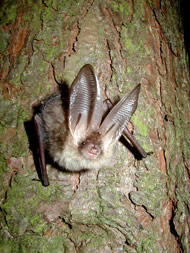Bats are perhaps one of the most misunderstood and maligned of small mammals. Possibly because we know so little about them, our fear of the unknown, has lead to a wealth of scare stories and fairytales that portray them as evil and creepy. However, these unusual nocturnal animals play many essential roles in our farming, forestry and urban landscape. Their decline is an indication of the sustainability of our countryside as a whole, because bats flourish best where the ecosystem is healthy and stable.
Bats are one of the most diverse groups of mammals in the world with over a thousand known species, but we understand very little about them. They live in very specific ecological niches, and as such are very vulnerable to change. Trees and tree related habitats play a very important part in the life cycles of nearly all bats, while some species have grown dependent on man made structures, roosting in the walls, exposed timbers and under roof tiles of both residential and commercial buildings.
All bats found in the UK are insectivorous, nocturnal flying mammals that occupy very specialised ecological niches. The 16 species known to be breeding in the UK and the various migrants that make the journey from other continents, each have their own unique characteristics, which are specifically developed for their own particular niche. This diversity has a considerable impact on conservation measures designed to protect them.
Compared with many other small mammals, bats are very long-lived. Some species of bats can live for over 30 years, which is a remarkable considering their size. It is likely that bat’s ability to go ‘torpid’ plays a major role in this long life. It is thought that bat memories have become very well developed, meaning that bats may remember important roost sites and feeding areas for many years. Combined with a habitual nature and ability to learn from other members of their colony, this means that some roost sites and foraging areas can be passed down through generations of bats. It is not inconceivable that some such sites could have been used for centuries.
More information can be found in the Arboricultural Association Guidance Note - Trees and Bats, written by Andrew Cowan 2004. Download order form here
For more information e-mail: consulting@arborecology.co.uk
Ecology:
Bats + [ Activity
Survey - Legal Issues
- When an Offence has been
committed - Habitats
regulations licenses ] |
